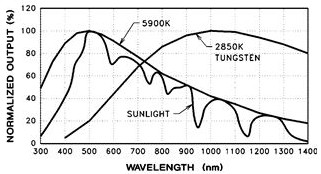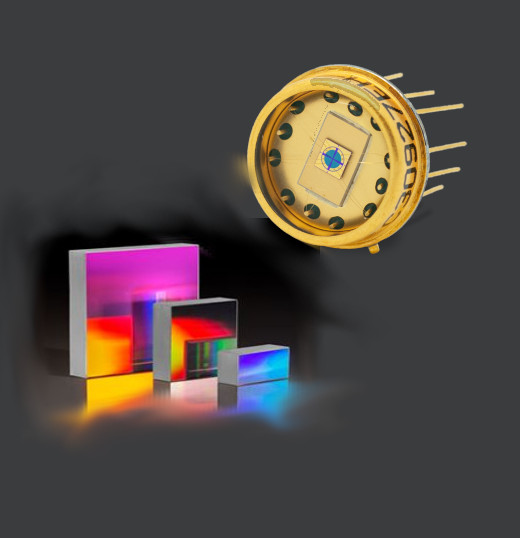
Common Light Sources
Incandescent lamps can be considered as black body radiators whose spectral output is dependent on their color temperature. The sun has approximately the same spectral radiation distribution as that of a black body @ 5900 K. However, as viewed from the surface of the earth, the sun’s spectrum contains H2O and CO2 absorption bands.

Black Body Sources Output vs. WavelengthBlack Body Sources Output vs. Wavelength
Fluorescent lamps exhibit a broad band spectral output with narrow peaks in certain parts of the spectrum. Shown below is a plot of the light output of a typical daylight type fluorescent tube.

Fluorescent Lamp Output vs. Wavelength
Due to their long operating lifetimes, small size, low power consumption, and the fact that they generate little heat, LEDs are the light sources of choice in many applications. When biased in the forward direction LEDs emit light that is very narrow in spectral bandwidth (light of one color). The “color” of the light emitted depends on which semiconductor material was used for the LED.
The intensity of the light emitted by visible LEDs is often given in units of millicandela. Millicandela is a photometric unit of measure which assumes the human eye as the detector. For most detectors other than the human eye the most convenient system for measurement is the radiometric system. Listed below is the typical light power output of some LEDs measured at two different forward drive currents. Note that LEDs of a given type can show a 5:1 manufacturing spread in power outputs.

LED Light Sources
| LED TYPE | COLOR | λP | POWER OUTPUT | |
| If = 1 mA | If = 10 mA | |||
| GaP | GREEN | 569 nm | 1.2 uW | 24.1 uW |
| GaAsP/GaP | YELLOW | 585 nm | 0.3 uW | 26.2 uW |
| GaAsP/GaP | ORANGE | 635 nm | 3.2 uW | 101.9 uW |
| GaAsP/GaAs | RED | 655 nm | 6.2 uW | 102,1 uW |
| AlGaAs | RED | 660 nm | 33.8 uW | 445.1 uW |
| GaP/GaP | RED | 697 nm | 54.3 uW | 296.2 uW |
| GaAlAs | INFRARED | 880 nm | 76.8 uW | 1512.3 uW |
| GaAs | INFRARED | 940 nm | 35.3 uW | 675.0 uW |
Article based on Application Notes from Excelitas Technologies Photometric and Radiometric Terms application note
Usłyszane w sieci
Rzeczą ważniejszą od wiedzy jest wyobraźnia.
Albert Einstein






